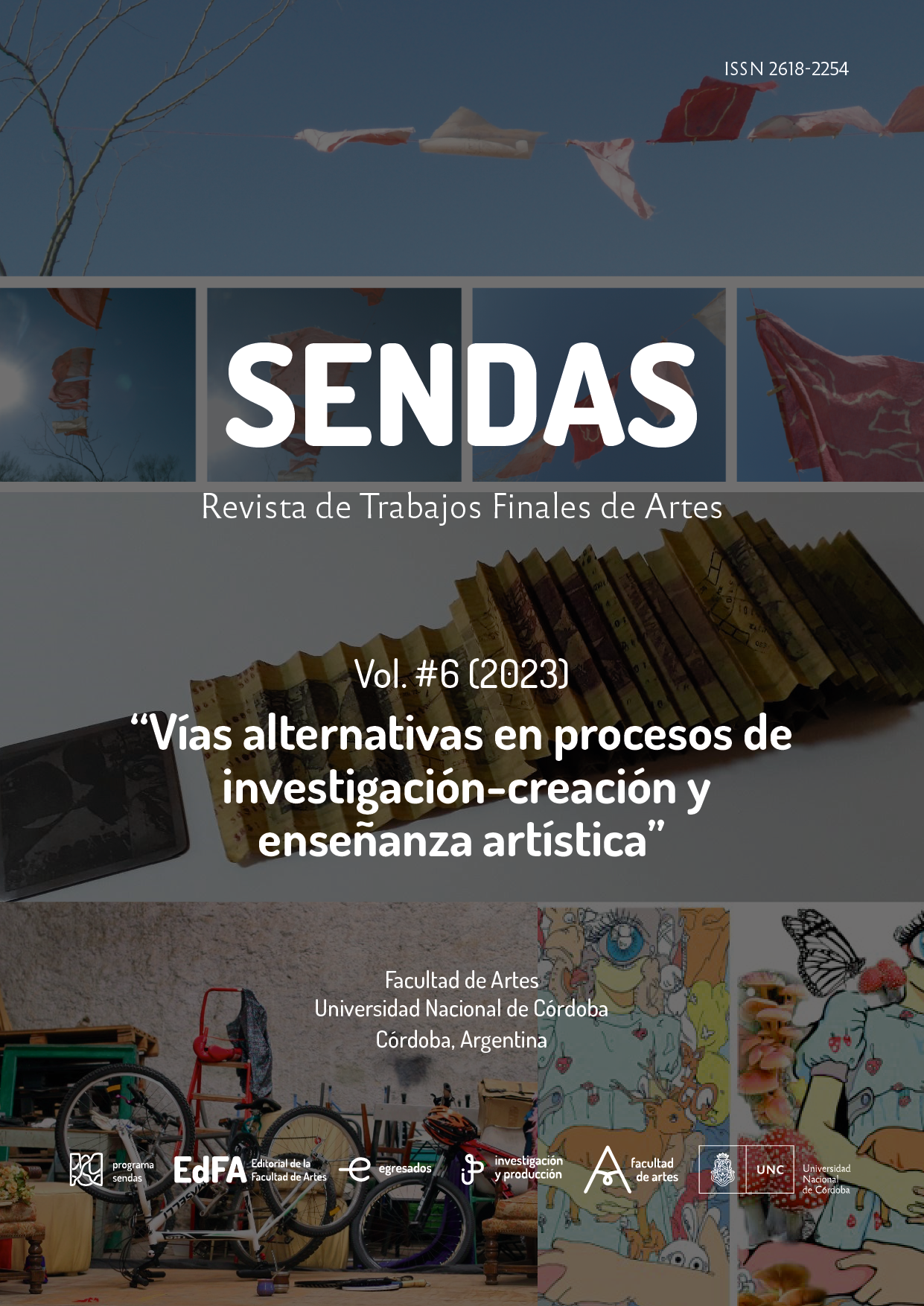From cinema and tv to theater: the cinematization of the play scene
Keywords:
performing arts, cinema, television, actorAbstract
This paper investigates the procedures of audiovisual language in the construction of the stagings of the theater group Brodda Teatro Producciones (Córdoba, Argentina). Its objective is to determine those characteristics that delineate a singular poetics and allow, at the same time, to reach a cinematization of the scene that results in "scenic films". In the scenic montage coexist and converge some procedures, which are transferred directly from own and pure materialities of the audiovisual, as well as others, which are adapted and translated into the languages of the theater. In this passage from the audiovisual to the scenic, parody will be the axis.
Downloads
References
Anijovich, R. et al. (2009). Transitar la formación pedagógica. Dispositivos y estrategias. Buenos Aires: Editorial Paidós.
Arguello Pitt, C. (2006). Nuevas tendencias escénicas. Teatralidad y cuerpo en el teatro de Paco Giménez (Pensamientos/02). Córdoba: DocumentA/Escénicas.
Bartís, R. (2003). Cancha con niebla. Buenos Aires: Editorial Atuel.
Daulte, J. (2010). Juego y compromiso: el procedimiento. En J. C. Gené y O. Cosentino (Eds.), La puesta en escena. En el teatro argentino del bicentenario (pp. 120-128). Buenos Aires: Fondo Nacional de las Artes.
Griffero, R. (2011). La Dramaturgia del Espacio. Santiago de Chile: Frontera Sur.
Grotowski, J. y Barba, E. (2000 [1968]). “El nuevo testamento del teatro”. En Grotowski, J. (comp.) Hacia un teatro pobre. (pp. 21-48) México: Siglo XXI.
Guarinos, V. (2003). Del teatro al cine y a la televisión: el estado de la cuestión en España. En Televisión, teatro y cine, Cuadernos de Eihceroa No. 2. Sevilla: Padilla Libros.
Kartún, M. (1995). Apuntes de dramaturgia colectiva. Sobretodo. Revista digital de crítica e investigación teatral. Teatro del Pueblo/SOMI. http://www.teatrodelpueblo.org.ar/dramaturgia/kartun001.htm.
Marín, F. (2018) Films escénicos: teatro de préstamos y piraterías. Revista Toma Uno, (6), 93-107. https://revistas.unc.edu.ar/index.php/toma1/article/view/20897/20497.
Marín, F. (2017) Dirección teatral. Procedimientos del montaje cinematográfico en la construcción de la puesta en escena. AURA. Revista de Historia y Teoría del Arte, (5), 95-112. https://www.ojs.arte.unicen.edu.ar/index.php/aura/article/view/409.
Marin, F. (2014). Piratear y recrear. Herramientas del cine al teatro [tesis de licenciatura, Universidad Nacional de Córdoba]. Argentina.
Mauro, K. (2011). La técnica de actuación en Buenos Aires. Elementos para un modelo de análisis de la actuación teatral a partir del caso porteño [tesis doctoral, Universidad de Buenos Aires]. Argentina.
Nieto-Ferrando, J. (2020). Ironía, parodia y recepción en el cine bajo el franquismo. De ’Esa pareja feliz’ (Luis García Berlanga, 1951) a ’Furia española’ (Francesc Betriu, 1974). Arte, Individuo y Sociedad, 32 (2), 387-404. https://doi.org/10.5209/aris.63709.
Pacheco, C. (2018, 20 de septiembre). La ciencia ficción se cuela en el teatro. La Nación. https://www.lanacion.com.ar/espectaculos/teatro/la-ciencia-ficcion-se-cuela-teatro-nid2173617/.
Pons, C. (2021). Montaje y yuxtaposición visual en la construcción escénica [tesis de licenciatura, Universidad Nacional de Córdoba]. Argentina.
Pavis, P. (1998). Diccionario de teatro. Barcelona: Paidós.
Sánchez-Biosca, V. (1991). Teoría del montaje cinematográfico. Valencia: Editorial Filmoteca de la Generalitat Valenciana.
Spregelburd, R. (2001). Fractal, una especulación científica.Buenos Aires: Libros del Rojas.
Triquell, X. (2017). Eje 3. Producciones cinematográficas contemporáneas: características y estrategias narrativas: Los géneros cinematográficos, entre la historia de la sociedad y la historia de un lenguaje. Culturas, 11. https://bibliotecavirtual.unl.edu.ar/publicaciones/index.php/Culturas/article/view/7004.
Downloads
Published
Issue
Section
License
Copyright (c) 2023 Sendas

This work is licensed under a Creative Commons Attribution-NonCommercial-ShareAlike 4.0 International License.
Commercial use of the original work and any derivative works is not permitted, and distribution of derivative works must be made under a license equal to that which governs the original work.







